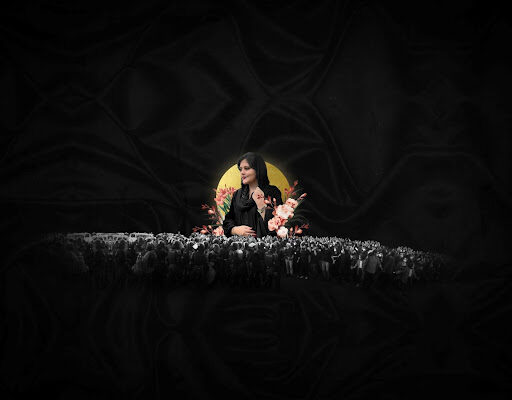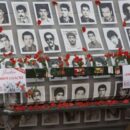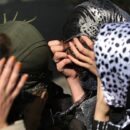An ‘emerging secular, democratic consensus’ stares Iranian theocracy in the face

An ‘emerging secular, democratic consensus’ stares Iranian theocracy in the face
ARAB NEWS | JONATHAN GORNALL | 11-23-2022
- Report by Tony Blair Institute for Global Change says ongoing protests reflect yearning for secularization of society
- Expert says young people witnessing great changes taking place in the region want similar developments at home
LONDON: On Sept. 13, Mahsa Amini, a 22-year-old Iranian woman, was arrested in Tehran for violating the Islamic republic’s strict dress code for women. In the custody of the Gasht-e Ershad — the “Guidance Patrol,” or morality police — she suffered a catastrophic head injury and, after three days in a coma, died in hospital.
Her death was the trigger for hundreds of protests across the country, which have seen men and women take to the streets in vast numbers, with women openly shunning the obligatory wearing of the hijab and cutting their hair in public in a gesture of defiance.
Now a new report from the Tony Blair Institute for Global Change — TBI — backed by two consecutive polls of thousands of Iranians, has concluded that the widespread rejection of the hijab is nothing less than a symbol of a nationwide yearning for regime change.
Such is the “unprecedented secularization” sweeping Iran that the TBI concludes that “Iran’s society is no longer religious.” (AFP)
The current protests are “no flash-in-the-pan moment,” says Kasra Aarabi, co-author of the report and the Iran Program lead at TBI’s Extremism Policy Unit.
“The protests we are seeing now are unprecedented in their longevity, and in their size. But they are a continuation of the trend for unrest that emerged in 2017, since when we’ve seen Iranians consistently taking to the streets.”
Aarabi, a non-resident scholar at the Middle East Institute in Washington and a native Farsi speaker, believes that the current unrest, some of the worst seen in Iran since the revolution in 1978 replaced the modernizing regime of the Shah, is a pivotal moment for Iran.
“This is the beginning of the end of the Islamic Republic,” he said.
“It’s been clear for years that the Iranian people don’t want reform, they want regime change, the downfall of the Islamic Republic in its entirety and the creation of a secular democracy.”
Young people in Iran, he says, are witnessing the great changes taking place elsewhere in the region, from the bridge-building of the Abraham Accords to the great modernizing reforms in Saudi Arabia, “and they’re thinking, ‘Why can’t we have that?’”
The TBI report draws on two polls carried out among tens of thousands of Iranians, which demonstrate the extent to which Iran has become a secular society, despite more than 40 years of life under a hard-line Shiite theocracy.
Key findings include that men and women in Iran are almost equally opposed to the mandatory wearing of the hijab, rejected by 70 percent of men and 74 percent of women.
This opposition also spans what might otherwise be expected to be the divide between town and country, where people are traditionally considered to be more conservative in outlook.
Only 21 percent of urban Iranians believe in the practice, support that rises only to 28 percent among rural communities.
Predictably, rejection of the compulsory wearing of the hijab is strongest among younger people — 78 percent of respondents aged between 20 and 29 oppose it.
Yet the practice is also opposed by 68 percent of Iranians aged between 30 and 49, and 74 percent aged over 50 — the so-called revolution generation.
Only a small minority of Iranians support the practice — just 13 percent of women and 17 percent of men.
The hijab protests, says the TBI, are clearly about regime change: 84 percent of those who oppose the dress code also want to see an end to the Islamic Republic.
Furthermore, “the anti-regime protest movement in Iran is fundamentally secular,” said the report, adding that “76 percent of Iranians who want regime change, also consider religion unimportant in their lives.”
New report showes the widespread rejection of the hijab is nothing less than a symbol of a nationwide yearning for regime change. (AFP)
In fact, such is the “unprecedented secularization” sweeping Iran that the TBI concludes that “Iran’s society is no longer religious.”
Only a declining minority in the theocratic republic follows the Islamic obligation to pray five times a day, ranging from 33 percent of rural Iranians to only 26 percent of urbanites.
Analyzed in terms of education, only 26 percent of Iranians with a university degree pray five times a day, while the percentage for people with a high-school diploma or lower is little different, at 28 percent.
Although the report, “Protests and polling insights from the streets of Iran: How removal of the hijab became a symbol of regime change,” was published on Tuesday, it contains previously unpublished data from two surveys carried out in Iran in 2020 and 2022.
This, says the TBI, demonstrates that the issue of the hijab and the yearning for the secularization of Iranian society has been simmering for years.
“Today’s protests are the consequence of the huge gap between the regime and the people of Iran,” said Aarabi.








